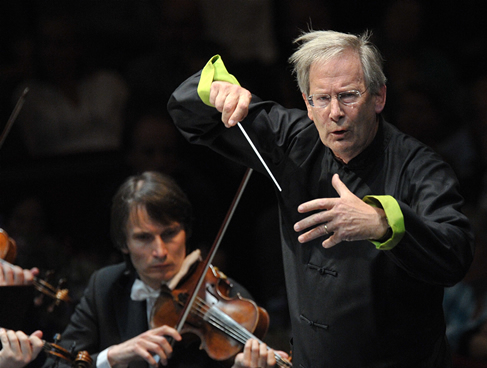Over the years, the Triangle has heard Historically Informed Performances from several chamber orchestras such as Apollo’s Fire. Carolina Performing Arts is presenting a pair of performances encompassing four major symphonies of Beethoven by Orchestre Révoluntionnaire et Romantique, one of the most highly regarded full-sized Early Music orchestras, led by John Eliot Gardiner. Their complete Beethoven symphonies’ recording has set the standard since it was issued.
I do not use “revelatory” loosely but it aptly describes the opening November 12 concert. The orchestra easily filled the UNC Memorial Hall stage. Gardiner divided the violins with the first violins on his left and the second violins on his right. Cellos were seated behind the first violins with the double basses and French Horns on risers behind them. Violas were seated behind the second violins with the two valveless trumpets on a riser behind them and the timpani nearby. Woodwinds were seated on risers between the horns and trumpets. Period orchestras play at a lower pitch than modern ones. String instruments used gut strings, lower tension, and differences in the bridges. Most striking visually are the valveless or natural horns and trumpets. To play a wider chromatic range, the horn players must keep interchanging several coils of tubing of different lengths. The valveless trumpets are much longer than modern ones and players have to have several trumpets with different tube lengths. From my balcony seat, it looked like each player had a pair of instruments. Woodwinds, bassoons, clarinets, flutes, and oboes have much more strongly contrasted colors and timbres.
Gardiner’s choice of the Overture to Beethoven’s ballet, The Creatures of Prometheus, Op. 43 to open the concert was doubly apt, especially since he reversed the playing order of the two symphonies from the printed program. The overture opens with a solemn, slow introduction leading to a sprightly fast section which Gardiner led with great verve.
Before leading Symphony No. 3 in E-flat, Op. 55 (Eroica), the conductor addressed the audience from the stage. Beethoven was much taken with the concept of “hero,” Gardiner said, and especially the myth of Prometheus who defied the gods to give fire to mankind and was eternally punished. The other connection comes from the fact the Prometheus theme from the 16th dance in the complete ballet is used as the theme in the “Eroica’s” final movement’s magnificent set of variations. The violins stood for the performance of the overture but were seated for the rest of the concert.
Gardiner led a blistering, intense performance of the “Eroica” symphony with plenty of momentum in the fast passages, such as the first and third movements and an underlying impulse in the magnificent slow second movement. The strong contrast between the string band and the wind band was striking. The unique, pungent timbre of the woodwinds was delightful. The sound world of the valveless horns was in a total contrast to the flashy, polished sound of modern horns. The color palette was much wider and the much harder to play period horns were less smooth. There was nothing dull or routine about this Eroica performance as Gardiner’s musicians played the socks off Beethoven’s boundary-breaking giant of a symphony. The playing of the principal oboist was outstanding.
Too often Beethoven’s Symphony No. 4 in B-flat, Op. 60 is regarded as a classical throwback to the Haydn-Mozart influenced models of his first two symphonies. While it is genial and gentle compared to the Eroica, it does have some innovative writing for the timpani and conjures up mysterious episodes beneath its robust, sunny and rhythmically vital surface. The pair of bassoons was delightfully pungent. Gardiner and his terrific players led an enchanting performance capped by a prolonged, sincere standing ovation. This group ought to be booked every time it does an American tour.











